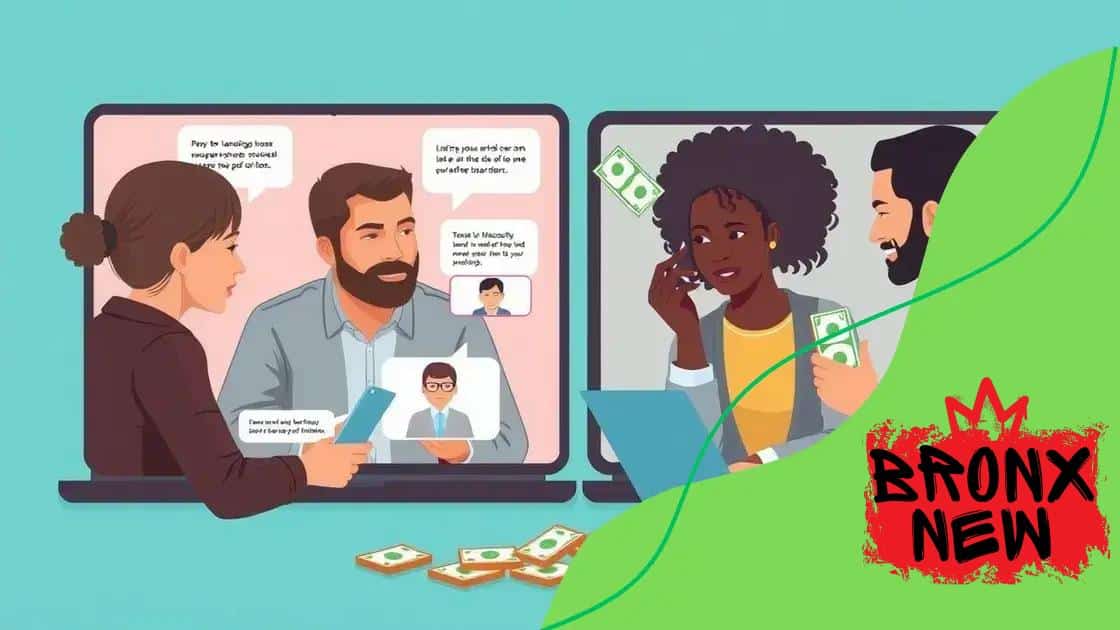The growth of peer-to-peer lending in 2025

The growth of peer-to-peer lending in 2025 will be driven by advancements in technology, providing borrowers with lower rates and faster access to funds while offering investors attractive returns and new opportunities.
The growth of peer-to-peer lending in 2025 promises exciting changes in how we think about borrowing and lending money. Have you ever wondered how this model could impact your financial decisions?
Understanding peer-to-peer lending
Understanding peer-to-peer lending is essential as we look at its growth in 2025. This innovative approach connects borrowers directly with lenders, cutting out traditional banks. By doing this, both parties can benefit financially.
Peer-to-peer lending works through online platforms that facilitate the loans. These platforms allow individuals to lend money to others while earning interest. It’s crucial to recognize how this model differs from conventional banking.
How Peer-to-Peer Lending Operates
The process begins when a borrower requests a loan. The platform reviews their financial information and assigns a credit score. Based on this score, lenders can decide whether to fund the loan.
Many choose to participate in this system because it offers better returns than traditional banking. For borrowers, the interest rates are often lower compared to banks. Here are some key elements:
- Direct connection between borrowers and lenders.
- Online platforms streamline the process.
- Potential for higher returns for lenders.
- Lower interest rates for borrowers.
As individuals become more familiar with this lending model, its popularity continues to rise. Moreover, these platforms often provide detailed information about borrower profiles, enabling informed decisions for lenders. It’s also essential to consider the risks involved.
Risks of Peer-to-Peer Lending
While there are potential gains, there are also risks. Borrowers may default on loans, which affects lenders. It’s crucial to understand these challenges before engaging.
However, with proper research, both borrowers and lenders can find opportunities that meet their financial needs. As we continue to explore the evolution of this market, stay informed about the developments and changes in peer-to-peer lending.
Key trends driving growth in 2025
Key trends driving growth in 2025 are essential for understanding how peer-to-peer lending will evolve. The financial landscape is changing rapidly, and these trends will shape the future of lending.
One major trend is the adoption of advanced technology. As more people become comfortable with digital platforms, peer-to-peer lending is becoming increasingly accessible. Borrowers can apply for loans from the comfort of their homes, while lenders can review lending opportunities quickly.
Increased Regulation and Security
As peer-to-peer lending grows, regulatory oversight is also increasing. This is crucial for building trust. Lenders want to know their money is safe, and borrowers want fair terms. As regulations tighten, expect platforms to enhance security features.
Another trend is the rise of alternative lending options. Traditional banks are often slower to adapt to new models, whereas peer-to-peer lending offers faster responses. This agility can attract more borrowers.
- Emerging technologies streamline application processes.
- Increased security boosts consumer confidence.
- Alternative lending is becoming more popular than banks.
- Financial literacy initiatives help borrowers make informed choices.
Additionally, financial literacy is taking center stage. As more educational resources become available, consumers are learning about their options. This knowledge empowers them to choose peer-to-peer lending over other methods.
As we look toward 2025, these trends will not only influence how people borrow and lend but also enhance the overall experience of users in the peer-to-peer lending space. It’s a rapidly changing environment that promises growth and opportunity.
Benefits for borrowers and investors

Benefits for borrowers and investors in peer-to-peer lending are significant and worth exploring. This unique lending model not only creates opportunities for individuals needing funds but also opens up new avenues for investors.
For borrowers, one of the most substantial advantages is access to lower interest rates. Traditional banks often have rigid lending criteria that can exclude many consumers. In contrast, peer-to-peer platforms evaluate borrowers differently, often leading to more favorable terms.
Advantages for Borrowers
Borrowers also benefit from a quicker application process. Unlike banks, which may take weeks to approve loans, peer-to-peer lending can provide funding in a matter of days. This speed is crucial for individuals needing urgent financial assistance.
Another point to consider is the ability to access loans with varying amounts. This flexibility allows borrowers to find solutions that fit their specific needs.
- Competitive interest rates compared to traditional banks.
- Faster funding timelines.
- Ability to negotiate loan terms.
- Access to different types of loans.
For investors, peer-to-peer lending offers the chance to earn attractive returns on their money. Instead of receiving minimal interest from savings accounts, investors can earn higher interest rates by funding loans directly to borrowers.
Advantages for Investors
Investing in peer-to-peer loans allows individuals to diversify their portfolios. By spreading investments across multiple loans, they can mitigate risks while still earning decent returns. Additionally, investors have the opportunity to support individuals and small businesses, providing a sense of community involvement.
While there are risks associated with lending, the potential for higher returns makes peer-to-peer lending an appealing option. Investors can also utilize technology to track their investments and assess the performance of different loans.
Challenges and risks to consider
Challenges and risks to consider in peer-to-peer lending are crucial for both borrowers and investors. While this model offers many advantages, it is essential to understand the potential pitfalls.
One of the main risks for lenders is borrower default. This occurs when a borrower fails to repay their loan. If this happens, the lender may lose some or all of their invested money. Thus, it is vital for lenders to assess borrowers’ creditworthiness carefully.
Understanding Credit Risk
Credit risk is the possibility that a borrower will not fulfill their loan obligations. Peer-to-peer platforms usually provide credit scores and financial background checks, but these are not foolproof. Lenders must do their due diligence when evaluating potential borrowers.
- Borrower defaults can lead to financial loss.
- Credit assessments may not be fully reliable.
- High-risk borrowers could affect overall returns.
- Economic downturns may increase default rates.
Another challenge is the lack of regulation compared to traditional financial institutions. While some oversight exists, peer-to-peer lending platforms may not be as tightly regulated as banks. This can impact the security of investments and the protection of personal information.
Market and Economic Factors
Market conditions can also influence peer-to-peer lending. If economic uncertainty rises, borrowers may struggle more to repay their loans, leading to higher default rates. Lenders need to consider these external factors that can affect their investments.
Finally, liquidity is a concern. Once funds are lent, they may be tied up for an extended period, making it difficult for lenders to access their money quickly. This lack of liquidity can be a significant drawback for those needing immediate access to cash.
The future of lending technology
The future of lending technology is promising and is expected to transform the peer-to-peer lending landscape significantly. As technology continues to evolve, it will enhance the efficiency and accessibility of lending platforms.
One major trend is the integration of artificial intelligence. AI can analyze vast amounts of data quickly, providing accurate risk assessments for borrowers. This helps in making informed lending decisions, thus reducing the chances of defaults.
Blockchain Technology and Its Impact
Another innovative aspect is the use of blockchain technology. This decentralized system enhances security and transparency in transactions. Borrowers and lenders can track all activities in real-time, ensuring a trustworthy environment.
- Improved data analysis for better decision-making.
- Increased security through decentralized ledgers.
- Enhanced transparency in transactions.
- Faster processing times for loan approvals.
Alongside AI and blockchain, the rise of mobile applications is changing how users interact with lending platforms. People can now apply for loans and manage their investments directly from their smartphones. This convenience attracts more participants to the lending market.
Regulatory Adaptations
With these technological advancements, regulations will also need to adapt. Authorities will likely create new frameworks to ensure consumer protection and compliance in the evolving landscape, balancing innovation with security.
The future of lending technology lies in continuous improvement and adaptation to market demands. By embracing these changes, peer-to-peer lending can offer innovative solutions that benefit both borrowers and investors.
FAQ – Frequently Asked Questions about Peer-to-Peer Lending
What is peer-to-peer lending?
Peer-to-peer lending is a method that allows individuals to lend and borrow money directly from each other, without involving traditional banks.
What are the benefits for borrowers in peer-to-peer lending?
Borrowers often enjoy lower interest rates and quicker access to funds compared to traditional banks.
How can investors benefit from peer-to-peer lending?
Investors can earn higher returns on their money by lending directly to borrowers through these platforms.
What risks are associated with peer-to-peer lending?
The main risks include borrower defaults and lack of regulation, which can impact the safety of investments.





